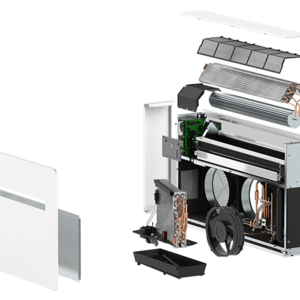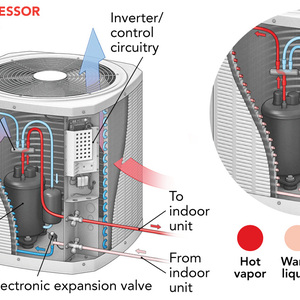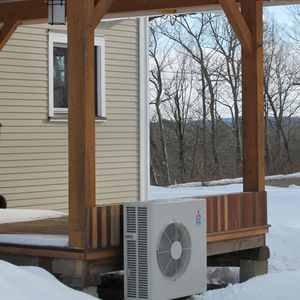
When considering the best choices to heat and cool high-performance homes, my mind immediately goes to heat pumps. They are very efficient systems that facilitate electrification of homes. However, there are a variety of tradeoffs and considerations around types of systems, climate zone, size of heating and cooling loads, and installation. Some of these can have a substantial impact on the performance and ‘greenness’ of the system. Let’s review some of them.
Minisplits
Minisplits are probably the most familiar type of system. In heating mode, they extract heat from the outdoor air and pump it indoors via refrigerant. In cooling mode, it is the opposite, and they extract heat from the indoor air and pump it outside much like a typical central a/c system. (For a detailed review of the refrigerant cycle see Heat Pumps for Cold Climates.)

A wide variety of well-established manufacturers offer high-performance systems with multiple options including ductless wall-mounted, floor-mounted, and recessed ceiling systems, as well as a variety of ducted offerings with options for small to fully centralized distribution systems.

Cold-climate specific systems are suitable for homes in climate zone 6 since the practical lower operating limit is typically around -15°F. In climate zones 7 and 8, these systems can cover a substantial portion of heating loads but need to be supplemented with a secondary heat source such as electric resistance baseboard, cove heaters, or heat strips (in line with ducted systems).
However, progress is being made as the Carrier Infinity Series can maintain 75% output at -22°F. Additionally, the Department of Energy launched the Residential Cold Climate Heat Pump Technology Challenge that includes an optional goal of optimizing performance at -15°F. It will be interesting to see how…
Weekly Newsletter
Get building science and energy efficiency advice, plus special offers, in your inbox.

This article is only available to GBA Prime Members
Sign up for a free trial and get instant access to this article as well as GBA’s complete library of premium articles and construction details.
Start Free TrialAlready a member? Log in














3 Comments
In winter, would the refrigerant that travels to a minisplit be heated to a higher temperature than the water / glycol mixture in an air to water heat pump? If so, does this mean the air to water heat pump operates at a higher efficiency?
I am new to learning about HVAC, which is likely leading to me using less than ideal terminology.
Thanks for your help,
Ben
Hi Ben - Yes, the refrigerant traveling to the heat exchanger in a minisplit refrigerant-based heat pump is usually hotter than the water/glycol mix supplied by an air-to-water heat pump. However, these are not meaningful criteria to compare when trying to understand efficiency differences between the two system types.
Typically 1:1 or 1:2 (meaning 1 outdoor unit and 1 or 2 indoor emitter heads) minisplit cold-climate heat pump systems and a cold-climate air-to-water heat pump such as Arctic perform with very similar efficiencies. They are both highly efficient systems. One key term here however is "cold-climate", because a manufacturer such as Mitsubishi sells units that are more optimized for cold temperatures and heating system efficiency, which are a bit more expensive (and more efficient) than their units which are more optimized for cooling and A/C.
The 1:1 and 1:2 ratios are also important because maintaining high efficiency in refrigerant-based systems gets a bit more challenging when you add more minisplit "heads" or thermostat "zones" to a refrigerant-based system. Hydronic air-to-water systems do not face the same challenges because they have a central thermal storage "buffer" tank which allows the outdoor heat pump to run more efficiently and gives you the option of adding many thermostats without losing efficiency.
I think you may have been getting at the idea that in air-to-water systems, a lower supply water temperature to a radiant floor or a wall-mounted or concealed hydronic fan coil DOES correlate directly to high efficiency. Typical operation temps are 100-120F. Arctic can reach a max of 131F in their flagship EVI line. supplying 100F water to a radiant floor instead of 120F is very doable and can result in about a 20% improvement in efficiency.
I do not have direct details on how refrigerant temps effect efficiency but it is not something the homeowner or installer or designer can control for typically in mini-split of other refrigerant-based systems so I may be mistaken but I don't think it is important in this discussion.
Also new to heat pumps, but getting info slowly as if I move and do a new build I may not be allowed to use a NG hi-eff. boiler. Having cooling available is an added bonus, but I'm curious about ducting. Since heat rises, air from the heating cycle will of course rise from the floor ducts. But when it comes to cooling, cool air drops, so is it desirable that cool air be directed into ceiling vents?
Also, what is the duct air velocity and noise in heat pump systems? Can they use mini fans in each duct, rather than just one big blower feeding the plenum like the old furnaces used to do? One thing I like about HW baseboard is that it is silent and not drafty, although I do have a large ceiling fan running slowly 24/7 to keep the air moving gently.
Log in or become a member to post a comment.
Sign up Log in